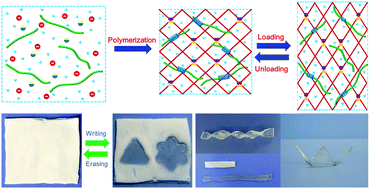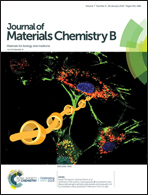Dual physically crosslinked hydrogels based on the synergistic effects of electrostatic and dipole–dipole interactions†
Abstract
A dual physical crosslinking (DPC) strategy based on the synergistic effects of electrostatic and dipole–dipole interactions was used to construct strong and tough hydrogels. The DPC hydrogels were synthesized by one-step copolymerization of acrylic acid (AAc) and acrylonitrile (AN) monomers in chitosan (Ch) solutions. The electrostatic and dipole–dipole interactions served as dynamic but highly stable associations, endowing the hydrogels with high strength, toughness and resistance to swelling. The mechanical properties of the DPC hydrogels strongly depended on the content of components. By adjusting the concentrations of Ch, AAc and AN in the prepolymerization solution, the hydrogels displayed the maximum tensile strength (0.82 MPa) and toughness (2.72 MJ m−3) while being subjected to a strain of more than 800%. The dual noncovalent bonding strengthening mechanism offered a universal strategy for enhancing the comprehensive mechanical properties of hydrogels. Moreover, the DPC hydrogels displayed good adhesive capability, reversible painting and moldable behavior.



 Please wait while we load your content...
Please wait while we load your content...